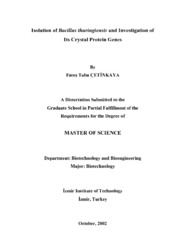Please use this identifier to cite or link to this item:
https://hdl.handle.net/11147/3070Full metadata record
| DC Field | Value | Language |
|---|---|---|
| dc.contributor.advisor | Güneş, Hatice | en |
| dc.contributor.author | Çetinkaya, Fatoş Tuba | - |
| dc.date.accessioned | 2014-07-22T13:50:49Z | - |
| dc.date.available | 2014-07-22T13:50:49Z | - |
| dc.date.issued | 2002 | en |
| dc.identifier.uri | http://hdl.handle.net/11147/3070 | - |
| dc.description | Thesis (Master)--Izmir Institute of Technology, Biotechnology, Izmir, 2002 | en |
| dc.description | Includes bibliographical references (leaves: 43-55) | en |
| dc.description | Text in English; Abstract: Turkish and English | en |
| dc.description | vi, 55 leaves | en |
| dc.description.abstract | Bacillus thuringiensis is a ubiquitous, gram-positive and spore-forming bacterium. During sporulation, it produces intracellular crystal proteins (cry proteins), which are toxic to insects. Because of its insecticidal activity, it has been used for nearly fifty years to control certain insect species among the orders Lepidoptera, Coloeptera, and Diptera. However, it is still necessary to search for more toxins to control other insect orders and to provide alternatives for coping with the problem of insect resistance. The genetic diversity of B. thuringiensis strains shows differences according to the regions where they were isolated. Thus, each habitat may contain novel B. thuringiensis strains, which have some toxic effects on target spectra of insects. The aim of this study was to isolate B. thuringiensis strains from different environments and to identify the crystalline protein gene content of the isolates. Sixty five samples including soil, stored product dust, insect cadavers, and dry leaf residues were collected from Akhisar/Manisa, İzmir, and Ereğli/Konya. Three approaches were applied for the isolation of B. thuringiensis: sodium acetate selection, heat treatment, and endospore staining. Polymerase Chain Reaction (PCR) method was used for the characterization of cry gene content of B. thuringiensis strains. The universal primers specific to cry 1, cry2, cry 3, and cry 9 genes were used to detect the type of cry gene carried by each environmental isolate of B. thuringiensis strains. In addition, 16S rRNA based PCR-restriction fragment length polymorphism (RFLP) was carried out to confirm B. thuringiensis strains. Finally, SDS-PAGE analysis was optimized to detect protein profiles of crystal proteins obtained from B. thuringiensis isolates. It was found that, 136 of 359 isolates showed B. thuringiensis-like colony morphology and subterminal endospore position. One hundred isolates were screened by PCR and 18 of them were found to contain cry genes (5 cry 1, 3 cry3, and 10 cry 9). However, the cry 2 gene was not detected from any isolates. 16S rRNA based PCR-RFLPfor 18 isolates gave the same restriction pattern as positive controls, indicating that all 18 isolates were B. thuringiensis. SDS-PAGE studies for Cry 9 proteins of the isolates exhibited different protein profile from positive control of B thuringiensis strain. | en |
| dc.language.iso | en | en_US |
| dc.publisher | Izmir Institute of Technology | en |
| dc.rights | info:eu-repo/semantics/openAccess | en_US |
| dc.subject.lcc | TP248.27.M53 C48 2002 | en |
| dc.subject.lcsh | Biotechnological microorganisms--Isolation | en |
| dc.subject.lcsh | Bacillus thuringiensis | en |
| dc.subject.lcsh | Bacillus thuringiensis--Genetics | en |
| dc.title | Isolation of bacillus thuringiensis and investigation of crystal protein genes | en_US |
| dc.type | Master Thesis | en_US |
| dc.institutionauthor | Çetinkaya, Fatoş Tuba | - |
| dc.department | Thesis (Master)--İzmir Institute of Technology, Bioengineering | en_US |
| dc.relation.publicationcategory | Tez | en_US |
| item.languageiso639-1 | en | - |
| item.fulltext | With Fulltext | - |
| item.openairecristype | http://purl.org/coar/resource_type/c_18cf | - |
| item.openairetype | Master Thesis | - |
| item.grantfulltext | open | - |
| item.cerifentitytype | Publications | - |
| Appears in Collections: | Master Degree / Yüksek Lisans Tezleri | |
Files in This Item:
| File | Description | Size | Format | |
|---|---|---|---|---|
| T000120.pdf | MasterThesis | 610.13 kB | Adobe PDF |  View/Open |
CORE Recommender
Page view(s)
106
checked on Jul 22, 2024
Download(s)
190
checked on Jul 22, 2024
Google ScholarTM
Check
Items in GCRIS Repository are protected by copyright, with all rights reserved, unless otherwise indicated.